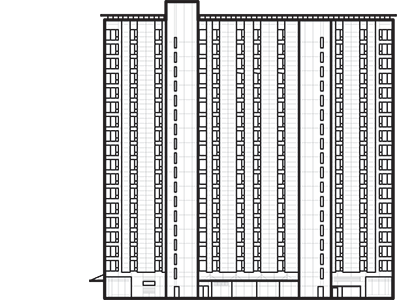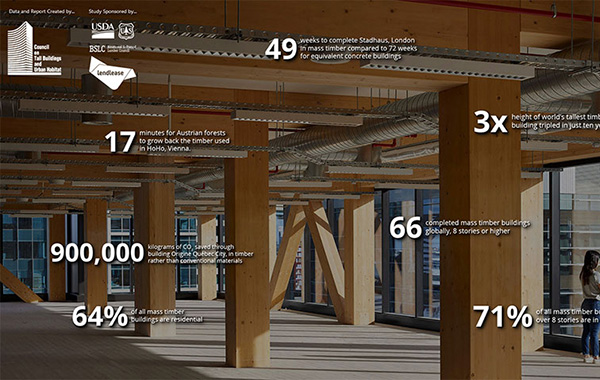Filter by
You must be a CTBUH Member to view this resource.

Brock Commons Tallwood House
Brock Commons Student Residence, Tallwood House at Brock Commons, Brock Commons Phase 1
Building
Completed
2017
Residential
Concrete-Timber Composite
LEED Gold v4 for Building Design & Construction (target)
57.9 m / 190 ft
18
305
2
15,115 m² / 162,697 ft²
Proposed
Construction Start
Completed
The Design Engineer is usually involved in the front end design, typically taking the leadership role in the Schematic Design and Design Development, and then a monitoring role through the CD and CA phases.
The Peer Review Engineer traditionally comments on the information produced by another party, and to render second opinions, but not to initiate what the design looks like from the start.
Other Consultant refers to other organizations which provided significant consultation services for a building project (e.g. wind consultants, environmental consultants, fire and life safety consultants, etc).
These are firms that consult on the design of a building's façade. May often be referred to as "Cladding," "Envelope," "Exterior Wall," or "Curtain Wall" Consultant, however, for consistency CTBUH uses the term "Façade Consultant" exclusively.
You must be a CTBUH Member to view this resource.
Usually involved in the front end design, with a "typical" condition being that of a leadership role through either Schematic Design or Design Development, and then a monitoring role through the CD and CA phases.
The Design Engineer is usually involved in the front end design, typically taking the leadership role in the Schematic Design and Design Development, and then a monitoring role through the CD and CA phases.
The Peer Review Engineer traditionally comments on the information produced by another party, and to render second opinions, but not to initiate what the design looks like from the start.
The Design Engineer is usually involved in the front end design, typically taking the leadership role in the Schematic Design and Design Development, and then a monitoring role through the CD and CA phases.
The CTBUH lists a project manager when a specific firm has been commissioned to oversee this aspect of a tall building’s design/construction. When the project management efforts are handled by the developer, main contract, or architect, this field will be omitted.
The main contractor is the supervisory contractor of all construction work on a project, management of sub-contractors and vendors, etc. May be referred to as "Construction Manager," however, for consistency CTBUH uses the term "Main Contractor" exclusively.
Other Consultant refers to other organizations which provided significant consultation services for a building project (e.g. wind consultants, environmental consultants, fire and life safety consultants, etc).
These are firms that consult on the design of a building's façade. May often be referred to as "Cladding," "Envelope," "Exterior Wall," or "Curtain Wall" Consultant, however, for consistency CTBUH uses the term "Façade Consultant" exclusively.
Material Supplier refers to organizations which supplied significant systems/materials for a building project (e.g. elevator suppliers, facade suppliers, etc).
2018 CTBUH Awards
17 January 2018 - CTBUH News
26 June 2017 - CTBUH Research

23 May 2022
CTBUH Research
This data study represents the significant recent momentum of the mass-timber movement worldwide. There are now 139 mass timber buildings around the world of eight...

23 May 2022
CTBUH Research
This data study represents the significant recent momentum of the mass-timber movement worldwide. There are now 139 mass timber buildings around the world of eight...

04 April 2022
Solomon Tesfamariam, University of British Columbia
The current trend in tall timber building design is a testament to the need for innovative structural systems. In this paper, a new, coupled cross-laminated...

25 April 2019
Daniel Safarik, CTBUH
In this paper, the Council on Tall Buildings and Urban Habitat seeks to define “innovation” in terms of the potentially transformative technologies and practices for...
Rune__Abrahamsen.jpg)
30 October 2017
Robert M. Foster, University of Queensland; Michael H. Ramage, University of Cambridge; Thomas Reynolds, The University of Edinburgh
Recent developments in the design and construction of progressively taller buildings using engineered timber as a structural material raise important questions about the language that...
17 January 2018
Check out all of our 2018 Tall Building Predictions, and dive into the full 2017 Tall Building Year in Review data report.
26 June 2017
The CTBUH has produced its latest Tall Buildings in Numbers research study, entitled "Tall Timber: A Global Audit."
22 June 2017
CTBUH New York held a presentation and panel discussion on the character and behavior of tall timber buildings, as well as the future opportunities with timber in New York and beyond.
22 June 2017
The CTBUH Seattle YPC heard from industry experts at a tall timber presentation, followed then by a networking event.
Subscribe below to receive periodic updates from CTBUH on the latest Tall Building and Urban news and CTBUH initiatives, including our monthly newsletter. Fields with a red asterisk (*) next to them are required.
View our privacy policy